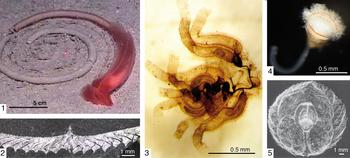Just out of the press - The Treatise on Invertebrate Palaeontology Part V, Hemichordata, Second Revision
This volume is the work of a larger group of specialists shown here and not the work of a single author as the previous versions by Oliver Meredith Boone Bulman.
Graptolithina are the focus of the volume, with over 650 described genera presented. It was initially published in 29 chapters in the Treatise Online journal (2014-2022), before the chapters were re-organized and revised for the book version.
Bildquelle: Screenshot
Examples of the Hemichordata (Fig. 1 in volume).
Bildquelle: Jörg Maletz
News vom 09.10.2023
Maletz, J. (Coordinating author). 2023. Treatise on Invertebrate Paleontology, Part V, Hemichordata, Second Revision, Including Enteropneusta, Pterobranchia (Graptolithina). (authors: D. E. B. Bates, E. Beli, E. D. Brussa, C. B. Cameron, R. A. Cooper, P. Gonzalez, A. Kozłowska, A. C. Lenz, D. K. Loydell, J. Maletz, S. Rigby, J. F. Riva, M. Steiner, B. A. Toro, A. H. M. VandenBerg, J. A. Zalasiewicz, Y. D. Zhang). The University of Kansas, Paleontological Institute, Lawrence, Kansas, U.S.A. xxx + 548 pp., 310 figs.
This second revision of the Graptolite Treatise was necessitated by an explosion of new research linking extant and fossil Hemichordata, as well as substantial increase in newly identified genera. Discussions to produce a new Graptolite Treatise began more than 20 years ago, with Charles E. Mitchell (Buffalo, N.Y, USA) and Michael J. Melchin (Antigonish, N.S., Canada) initiating the first steps with then Treatise Editor Roger Kaessler. In 2010, Jörg Maletz became the coordinating author of this volume, which was finally published in 2023, more than fifty years after the publication of the last version (Bulman, 1970).
Graptolithina are the focus of the volume, with over 650 described genera presented. It was initially published in 29 chapters in the Treatise Online journal (2014-2022), before the chapters were re-organized and revised for the book version.
This Second Revision of the Part V Treatise on Invertebrate Paleontology, dealing with the phylum Hemichordata, is a considerably extended version of the Graptolite Treatises of Bulman (1955, 1970), which primarily covered the Graptolithina, at the time interpreted as an extinct class of the Hemichordata. With the recognition of the Graptolithina as fossil members of the Pterobranchia and the identification of the benthic colonial pterobranch Rhabdopleura as an extant graptolite, the focus in this volume is extended to include the record of fossil Hemichordata and to also examine the soft-body anatomy in more detail. Zooidal anatomy is important for the interpretation of the fossil graptolites and their life style and points to the importance of modern biology in understanding the fossil record.
Scope of the Volume
This volume is aimed at providing the most complete and up-to-date information on the fossil Hemichordata, their taxonomy, and their use in the geological sciences. The inclusion of not only the Pterobranchia (Graptolithina) but also the Enteropneusta shows our increased knowledge of the relationships of this fascinating fossil group with extant groups of organisms. This approach connects the fossil graptolites with their closest relatives, largely known from extant organisms.
Graptolites, the main focus of this volume, have been used successfully in the understanding of lithostratigraphic successions, unraveling structural complexities in geology and, thus, are important biological objects enabling numerous geological interpretations. Lapworth (1878) first used graptolites to decipher the tectonic complexities in the succession of the Moffat Series, a milestone in graptolite research and a first hint on the importance of graptolite research to applied geology. Graptolite fusellum has been used to determine temperature and burial histories of Paleozoic sediments. Graptolite research, thus, goes far beyond the identification of taxa and the relative dating of successions that included graptolites as index fossils. It is not just a discipline for taxonomists and fossil collectors; the geological application of graptolites is still developing and modern data collection and database interpretations may infuse new life into graptolite research. In recent years, paleodiversity studies using graptolite faunas have become the focus of research on extinction and origination intervals in Earth’s history.
The Enteropneusta, unfortunately, have been neglected in the past because so few fossil ones were recognized, and even the extant enteropneusts were rarely investigated in much detail by biologists. Only through the renewed interest in the Burgess Shale biota and their preservation, fossil Enteropneusta have gained more interest. As a result, new fossil taxa have been studied and described.
Kontakt
Telefon +49 30 838 70678
E-Mail joerg.maletz@fu-berlin.de
Malteserstrasse 74-100, Haus C, Raum C.005
12249 Berlin


